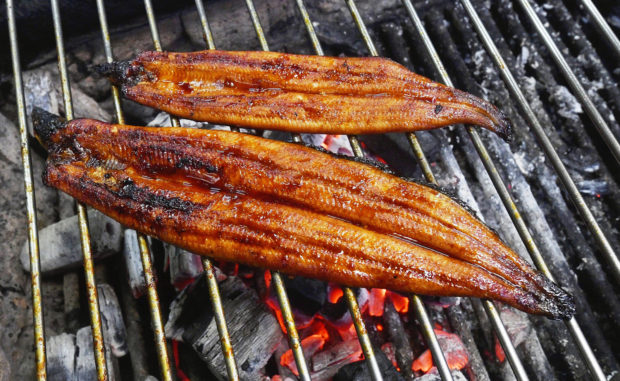
TOKYO — If “fattening” eels becomes common, it could also work to curb the surge of eel prices, according to observers.
This spring, the Union of Eel Farmers Cooperatives of Japan — a Shizuoka Prefecture-based organization of eel farmers — asked a Tokyo-based association of kabayaki-style eel restaurants and other groups to promote the fattened eels, and managed to obtain their support.
Kabayaki is a style of broiling eels after coating the fish with a sweet soy-sauce-based mixture.
About 99 percent of eels on the market in Japan are aquaculture products that have been raised from glass eels.
There is concern that Japanese eel resources are decreasing due to overfishing and other reasons.
The International Union for Conservation of Nature designated Japanese eels as an endangered species in 2014. In eel farming, glass eels caught in the ocean are raised in special ponds until fully grown.
It takes up to about 1½ years for the fish to reach about 200 to 250 grams, which is about the size suitable for kabayaki dishes or una-ju (kabayaki eel served on rice in a box).
A pioneer in eel fattening is Yamamoto Yoman, which cultivates eels in Tosa, Kochi Prefecture.
The company began full-scale operation of fattening eels from 2016, by extending the farming period of eels to about two years and raising the fish to about 400 grams.
The company has shipped more than 1,700 eels of that size so far.
“This farming method enables restaurants to serve two unaju dishes from one eel,” said Kanji Kawamura, 56, president of Yamamoto Yoman. “I hope this method will lead to efficient utilization of glass eels.”
However, a key challenge remains — the texture of eels.
When eels are fattened, naturally their bones grow bigger and thicker, making it difficult to swallow, as the bones may get stuck in diners’ throats.
Taking this into consideration, farmers came up with a method of reducing by about 30 percent the amount of a high-calcium type of feed, and instead giving the eels feed abundant in protein.
Such efforts help cultivate fleshy eels while containing the growth of their bones.
According to sources in the eel farming industry, in response to poor catches of young eel this season, the practice of fattening has spread among farmers in Shizuoka and Miyazaki prefectures as well.
Not only farmers, but also eateries that serve kabayaki and other eel dishes are making efforts in properly cooking fattened eels as their meat and skin has a tendency to become tough.
Kunio Wada, 74, of Taishoken, a restaurant specializing in eel delicacies in Sakawa, Kochi Prefecture, said when cooking fattened eels, he is required to carefully assess the tenderness of each eel and slightly change the grilling time depending on its size.
Shunsuke Sanda, 75, of Shibuya Matsukawa, an old eel restaurant in Shibuya Ward, Tokyo, pointed out the need to slowly grill them at low heat and also adjust the time to steam them.
According to the Fisheries Agency, the amount of young eels put into domestic farming ponds for the latest fishing season totaled 14.2 tons, down by about 30 percent from the previous season.
Since the 2006 fishing season and thereafter, the latest figure is the second lowest after 2013, when only 12.6 tons of young eels were put into farming ponds. The latest poor catch will likely drive up the price of eels.